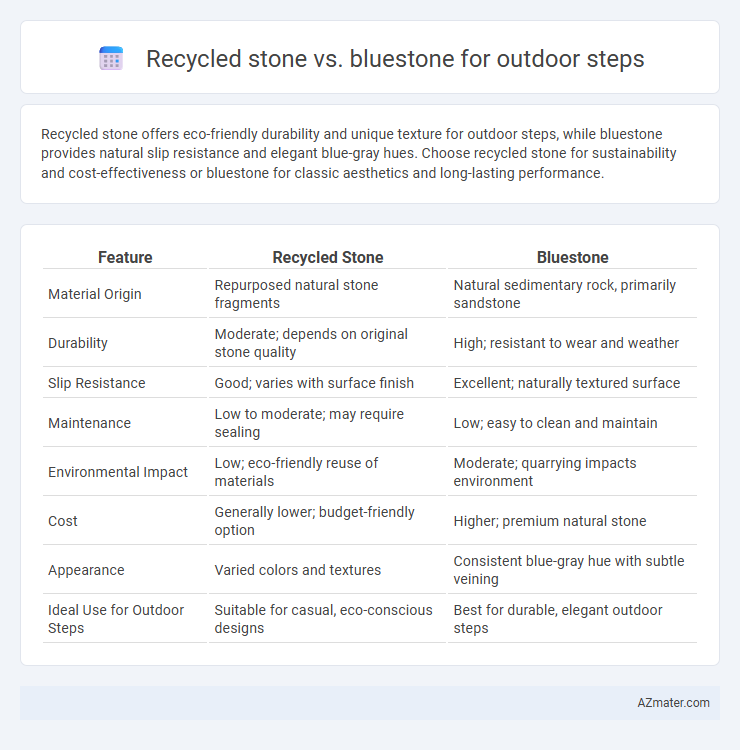Recycled stone offers eco-friendly durability and unique texture for outdoor steps, while bluestone provides natural slip resistance and elegant blue-gray hues. Choose recycled stone for sustainability and cost-effectiveness or bluestone for classic aesthetics and long-lasting performance.
Table of Comparison
| Feature | Recycled Stone | Bluestone |
|---|---|---|
| Material Origin | Repurposed natural stone fragments | Natural sedimentary rock, primarily sandstone |
| Durability | Moderate; depends on original stone quality | High; resistant to wear and weather |
| Slip Resistance | Good; varies with surface finish | Excellent; naturally textured surface |
| Maintenance | Low to moderate; may require sealing | Low; easy to clean and maintain |
| Environmental Impact | Low; eco-friendly reuse of materials | Moderate; quarrying impacts environment |
| Cost | Generally lower; budget-friendly option | Higher; premium natural stone |
| Appearance | Varied colors and textures | Consistent blue-gray hue with subtle veining |
| Ideal Use for Outdoor Steps | Suitable for casual, eco-conscious designs | Best for durable, elegant outdoor steps |
Introduction to Recycled Stone and Bluestone
Recycled stone consists of repurposed natural materials derived from demolished concrete, brick, or stone, offering an eco-friendly and cost-effective option for outdoor steps. Bluestone, a dense and durable sedimentary rock predominantly quarried in the northeastern United States, is prized for its rich blue-gray hues and natural slip resistance. Both materials provide unique aesthetic and functional benefits, with recycled stone emphasizing sustainability and bluestone highlighting natural beauty and longevity.
Material Composition: Recycled Stone vs Bluestone
Recycled stone for outdoor steps is composed of crushed concrete, brick, and natural stone fragments, offering a sustainable alternative with varied texture and color. Bluestone, a dense sedimentary rock primarily composed of feldspar and quartz, provides consistent durability and a smooth finish ideal for outdoor applications. The distinct mineral compositions impact weather resistance and maintenance, with bluestone typically exhibiting superior hardness and longevity compared to recycled stone.
Environmental Impact and Sustainability
Recycled stone for outdoor steps significantly reduces landfill waste and lowers the demand for new quarrying, promoting resource circularity and minimizing environmental degradation. Bluestone, while durable and natural, involves intensive mining processes that contribute to habitat disruption and higher carbon emissions. Choosing recycled stone supports sustainability goals by utilizing reclaimed materials and decreasing the overall ecological footprint associated with step construction.
Aesthetic Appeal and Design Versatility
Recycled stone offers a unique, rustic aesthetic with varied textures and colors that enhance natural outdoor settings, while bluestone provides a sleek, uniform appearance prized for its elegant blue-gray hues and smooth finish. Bluestone's consistent thickness and ability to be cut into precise shapes make it highly versatile for modern, geometric step designs, whereas recycled stone's irregularity lends itself to organic, eclectic layouts. Both materials are durable and weather-resistant, but choice hinges on whether the design prioritizes contemporary sophistication or eco-friendly character.
Durability and Weather Resistance
Recycled stone offers moderate durability and weather resistance, often depending on the source material quality and processing methods. Bluestone provides superior durability with high resistance to weathering, including freeze-thaw cycles, making it ideal for outdoor steps in harsh climates. Its dense, non-porous nature reduces water absorption and prevents cracking, ensuring long-term performance.
Installation Process and Complexity
Recycled stone steps involve a straightforward installation process consisting mainly of layering and compacting base materials before placing the stones, making it suitable for DIY projects due to its relatively uniform size and shape. Bluestone installation requires precise cutting and fitting because of its natural irregularities and weight, often demanding professional expertise to ensure proper alignment and stability. The complexity of bluestone lies in handling its uneven surfaces and varying thickness, which necessitates specialized tools and skillful craftsmanship to achieve a durable and aesthetically pleasing outdoor step.
Maintenance Requirements and Longevity
Recycled stone for outdoor steps typically requires less frequent sealing and is more resistant to chipping, resulting in lower maintenance demands over time compared to bluestone. Bluestone, known for its natural density and durability, may need periodic cleaning and sealing to prevent moss growth and weathering, especially in humid climates. While both materials offer substantial longevity, recycled stone often provides enhanced durability in high-traffic areas, extending the lifespan of outdoor steps beyond that of bluestone.
Cost Comparison: Recycled Stone vs Bluestone
Recycled stone offers a cost-effective alternative to bluestone for outdoor steps, often priced 30-50% lower due to its use of repurposed materials. Bluestone, a dense and durable natural stone, commands higher prices typically ranging from $15 to $30 per square foot, influenced by quarry source and finishing. While recycled stone minimizes upfront expenses and supports sustainability, bluestone's premium cost reflects its longevity and timeless aesthetic appeal in outdoor applications.
Slip Resistance and Safety Considerations
Recycled stone offers enhanced slip resistance due to its textured, irregular surface, making it a safer option for outdoor steps in wet or icy conditions. Bluestone, known for its natural cleft finish and dense composition, provides reliable traction but may become slippery when polished or worn smooth over time. Prioritizing slip resistance and surface texture in both materials is crucial to ensure optimal safety and reduce fall risks on outdoor steps.
Choosing the Right Option for Your Outdoor Steps
Recycled stone offers an eco-friendly choice with a unique, rustic texture ideal for environmentally conscious homeowners, while bluestone provides durable, slip-resistant surfaces with natural blue-gray hues perfect for classic outdoor steps. Consider factors like climate durability, maintenance needs, aesthetic preferences, and budget constraints when selecting between recycled stone and bluestone. Proper installation and sealing enhance longevity and safety, ensuring your outdoor steps combine functionality with style.

Infographic: Recycled stone vs Bluestone for Outdoor step
 azmater.com
azmater.com